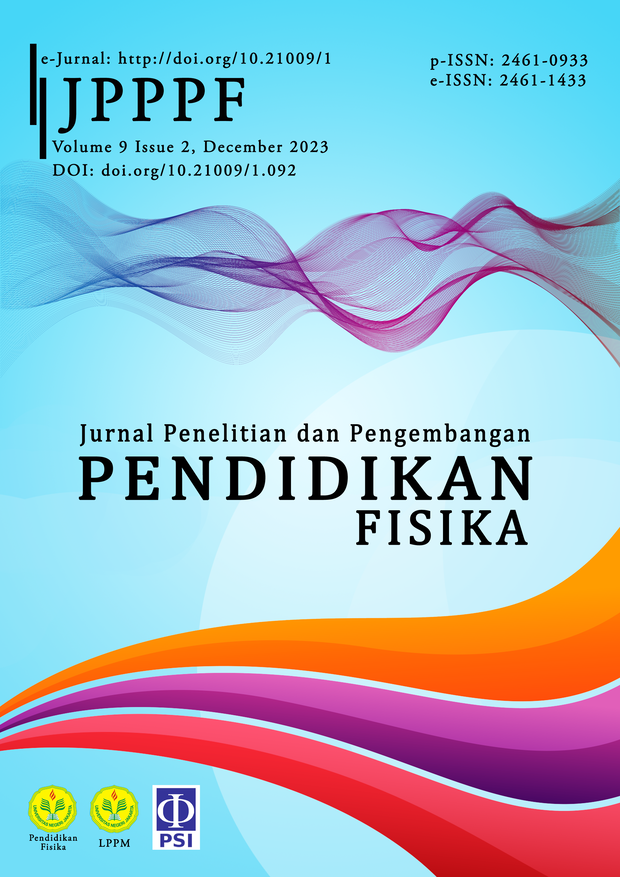The Development of Hallwachs Miracle Novel as a Media Science Literacy in Learning Photoelectric Topic
DOI:
https://doi.org/10.21009/1.09203Keywords:
media science literacy, novel, photoelectricity, physics learningAbstract
This study aims to develop a novel entitled "The Miracle of Hallwachs" as a medium for enhancing scientific literacy, particularly focusing on the physics concept of the photoelectric effect for third-grade high school students. The research employs the Research and Development (R&D) approach, utilizing the Analysis, Design, Development, Implementation, and Evaluation (ADDIE) development model. Data were collected through observation, interviews, and questionnaires, and both qualitative and quantitative analyses were conducted. Product testing involved assessments by material experts, media experts, and 31 students. The study's outcomes resulted in the creation of learning media in the form of audiobooks accessible through various devices. The media's feasibility was evaluated by experts in the field, including material experts, media experts, and Indonesian language teachers, as well as through a field trial with 31 students. Expert validation indicated a high level of appropriateness, with a 97% approval rate for material validation and a 94.29% approval rate for learning media validation. Based on this comprehensive assessment, it can be concluded that the novel under development is well-suited as a medium for enhancing media literacy in science, specifically in teaching physics with a focus on the photoelectric effect.
References
Brakhage, H, Gröschner, A, Gläser-Zikuda, M et al. 2023, ‘Fostering Students’ Situational Interest in Physics: Results from a Classroom-Based Intervention Study’, Research in Science Education, vol. 53, no. 5, pp. 993-1008, https://doi.org/10.1007/s11165-023-10120-x.
Dogan, OK 2021, ‘Methodological? Or dialectical?: Reflections of scientific inquiry in biology textbooks’, International Journal of Science and Mathematics Education, vol. 19, no. 8, pp. 1563-1585.
Eutsler, L 2021, ‘Making Space for Visual Literacy in Literacy Teacher Preparation: Preservice Teachers Coding to Design Digital Books’, TechTrends, vol. 65, no. 5, pp. 833-846, https://doi.org/10.1007/s11528-021-00629-1.
Gailey, CD 2020, ‘Newtonian and Quantum Physics for Babies: A Quirky Gimmick for Adults or Pre-science for Toddlers?’, Translating and transmediating children’s literature, pp. 319-332.
Halawa, S, Hsu, YS & Zhang, WX 2023, ‘Analysis of Physics Textbooks Through the Lens of Inquiry Practices’, Asia-Pacific Education Research, vol. 32, pp. 497-506, https://doi.org/10.1007/s40299-022-00671-4.
Hidayat, A 2022, ‘SECTIONS Model Analysis for Pre-Service English Teachers' Media Selection in Pandemic COVID-19’, International Journal of Instruction, vol. 15, no. 3, pp. 599-610.
Indrasari, W, Budi, AS & Fadilla, DP 2022, ‘The Development of Educational Aids for Restitution Coefficient Experiment Using Microcontroller’, Jurnal Penelitian & Pengembangan Pendidikan Fisika, vol. 8, no. 1, pp. 95-104, doi: 10.21009/1.08109.
Kadic, M, Milton, GW, Van Hecke, M & Wegener, M 2019, ‘3D metamaterials’, Nature Reviews Physics, vol. 1, no. 3, pp. 198-210.
Kallunki, V, Katajavuori, N, Kinnunen, P et al. 2023, ’Comparison of voluntary and forced digital leaps in higher education - Teachers’ experiences of the added value of using digital tools in teaching and learning’, Education and Information Technologies, pp. 1-26, https://doi.org/10.1007/s10639-022-11559-7.
Marrara, S, Semprebello, A & Vasi, S 2021, ‘Physical and historical principles of ionizing radiations with the flipped classroom method’, Atti della Accademia Peloritana dei Pericolanti-Classe di Scienze Fisiche, Matematiche e Naturali, vol. 99, p. 38.
Myers, J, Adams-Budde, M 2017, ‘Teaching literacy in the digital age: Inspiration for all levels and literacies’, International Society for Technology in Education, Eugene, OR, vol. 63, pp. 769-772, https://doi.org/10.1007/s11159-017-9649-y.
Nuridayu, N, Elfitra, L & Pujiastuti, I 2021, ’Minat Baca Siswa Kelas XI SMA Negeri 2 Tanjungpinang Tahun Pelajaran 2020/2021’, Student Online Journal (SOJ) UMRAH-Keguruan dan Ilmu Pendidikan, vol. 2, no. 1, pp. 115-119.
Permana, H, Purwahida, R, Muliyati, D, Rahmadini, D, Ambarwulan, D & Siswoyo, S 2021, ‘Hallwachs and the negatively charged particles’-the development of education comics’, Physics Education, vol. 56, no. 5, p. 055038.
Puspitarini, YD & Hanif, M 2019, ‘Using Learning Media to Increase Learning Motivation in Elementary School’, Anatolian Journal of Education, vol. 4, no. 2, pp. 53-60.
Santyasa, IW, Rapi, NK & Sara, I 2020, ’Project based learning and academic procrastination of students in learning physics’, International Journal of instruction, vol. 13, no. 1, pp. 489-508.
Suroso, J & Mudakir, I 2021, ‘Profile of high school students science literacy in east java’, In Journal of Physics: Conference Series, vol. 1832, no. 1, p. 012040.
van Zee, EH, Jansen, H, Winograd, K et al. 2013, ‘Integrating Physics and Literacy Learning in a Physics Course for Prospective Elementary and Middle School Teachers’, Journal of Science Teacher Education, vol. 24, no. 4, pp. 665-691, https://doi.org/10.1007/s10972-012-9323-y.
Wheaton, BR 2009, ‘Photoelectric effect’, In Compendium of Quantum Physics, Berlin, Heidelberg: Springer Berlin Heidelberg, pp. 472-475.











